Helianthus annuus ‘Teddy Bear’
Even though they look more like miniature mops than a stuffed animal, it’s still quite easy to understand how ‘Teddy Bear’ sunflowers got their name.
They’re fluffy, bright yellow, and a comforting small size – especially when compared to their relatives that can grow to 10 feet and taller!
Scientists have even determined that the double-bloomed sunflowers in the famous paintings by Vincent van Gogh were ‘Teddy Bear’ types, but they couldn’t find the gene mutation that gave them the green centers as depicted by the artist.

We link to vendors to help you find relevant products. If you buy from one of our links, we may earn a commission.
It’s easy to see why van Gogh was drawn to these beauties.
Kids tend to like them too, maybe because there’s just something so reassuring about a bouquet or container full of bright, fuzzy flowers.
And the Royal Horticultural Society awarded this cultivar the prestigious Award of Garden Merit in 2015.
Thankfully, you don’t just have to admire them at a florist’s or grocery floral section, as it’s entirely possible – and easy – to grow your own.
Most garden centers carry seeds or you can find them online from True Leaf Market, in a variety of packet sizes.
Just the thought of these sunny, spunky annuals makes me think of the lyrics to that Elvis tune, “I just wanna be your…”
So hum along with me, as I take you through the tips and techniques for growing your own ‘Teddy Bear’ sunflowers.
Here’s what I’ll cover:
Tips for Growing Teddy Bear Sunflowers
What Are Teddy Bear Sunflowers?
‘Teddy Bear’ sunflowers are adorable, starting with that name. But they have other charms, too.
An open-pollinated dwarf cultivar of Helianthus annuus, these annuals are characterized by fluffy, double-petaled blooms measuring five to six inches across.
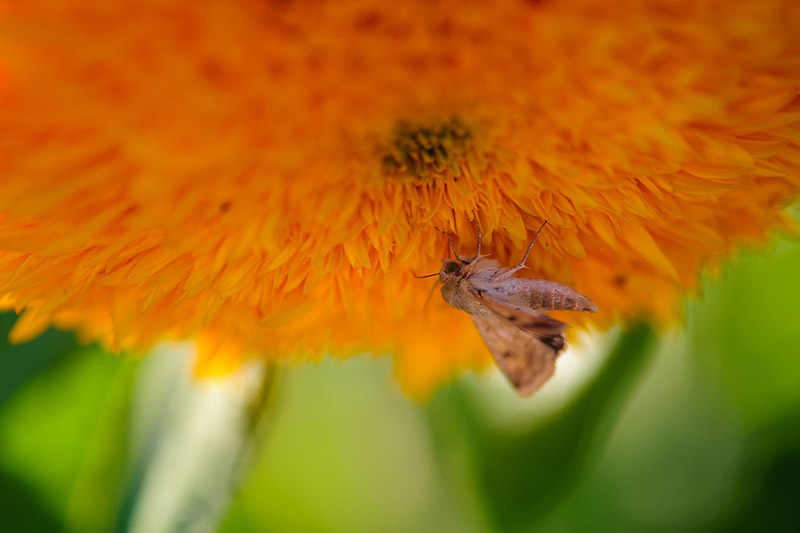
Even though this variety produces minimal pollen, the shaggy pom-pom flowers are beloved by bees and other pollinators.
Chefs and salad fans prize these blooms, too. The individual petals, which are actually florets, look pretty and taste great paired with mesclun mixes – or as an edible garnish on soups, cakes, and other decorative baked goods.
And at the end of the season, you can harvest the edible seeds, either for planting next year or roasting as a tasty and nutritious snack.
Each plant sends up one thick central stalk that branches into multiple double blooms, and reaches a mature height of just two to four feet tall.
They flower over a period of about five weeks, usually starting from around 75 days after direct sowing, and provide color for the rest of the summer.
Best Uses
Like the child’s beloved stuffed animal friend, these annuals are helpful in a lot of situations.
They’re a colorful choice for mixed beds or perennial borders. Their compact, bushy form is ideal for filling in the spaces in front of long-stemmed, tall H. annuus varieties in a garden or landscape.
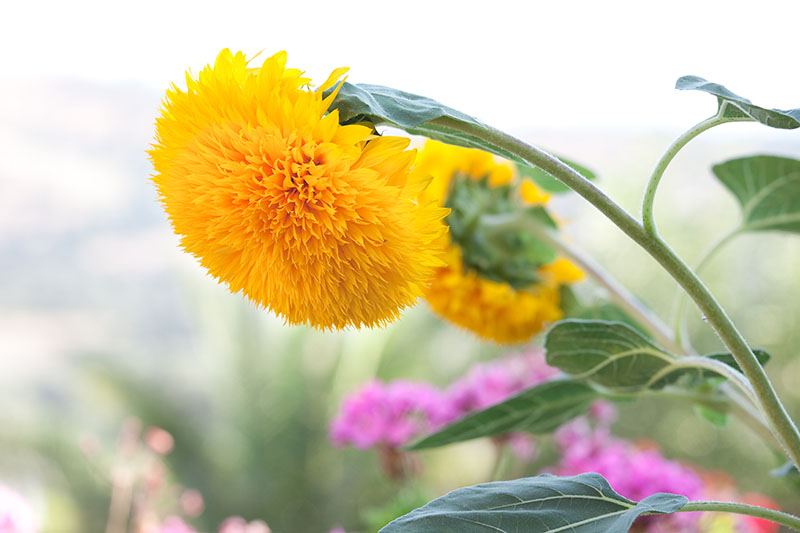
With large blooms on sturdy stems, they’re a top choice for cutting gardens and make attractive floral arrangements.
Since they bloom over a period of five weeks or more, you will have an ample supply to fill your vases.
Gardeners who want to attract pollinators will appreciate this variety, as will anyone who wants to save seeds for planting next year.
This cultivar is open-pollinated, so provided you are not growing it near any other H. annuus varieties, saved seed should produce flowers that are true to the parent plant.
They’re also a fine choice for growing in containers – or just about anywhere in the garden where they can get ample sun.
Since they’re so easy to grow and so charming, I also consider them a standout choice for a children’s garden.
Growing Tips
All of the advice from our guide to growing sunflowers applies to this petite variety.
To recap, H. annuus thrives in a full sun location, with at least six to eight hours of direct sunlight per day. Plants require organically rich, loose, well-draining soil.
For this cultivar in particular, here are a few tips:
1. Sow Seeds at the Right Time
Despite all the volunteers that you might have seen sprouting beneath your bird feeder, the safest bet for outdoor sowing is to wait for the soil temperature to reach 65-85˚F. This is the optimal temperature for successful germination. Alternatively, you can start seeds indoors.
2. Give Them Enough Room
They may not grow to the lofty heights of some of their H. annuus relatives, but ‘Teddy Bear’ sunflowers have a bushy growth habit. Space plants 18-24 inches apart.
3. Protect Young Plants
Birds, rabbits, squirrels and the like are fond of munching on the seedlings. Protect them with row covers or bird netting if you have trouble with those marauders in your garden.
4. Give Them Enough Time to Grow
It’s only a very general rule of thumb that smaller edibles grow more quickly. In this case, similar to a miniature winter squash, ‘Teddy Bear’ sunflowers take just as long to bloom as many of their much larger relatives. They may be short in stature, but they still need 75 days or so from planting to produce their gorgeous blooms.
5. Deadhead Regularly
If you cut spent blooms consistently, it will encourage the stems to produce more flowers throughout the season.
6. Avoid Pesticides on Edibles
Avoid the use of pesticides and herbicides at any time during the growing process if you intend to consume the petals, or the seeds.
A Cuddly Sunflower?
When I can’t see my loved ones in person, I try to write. One of my favorite sign-offs is, “Consider yourself hugged.”
‘Teddy Bear’ sunflowers are sort of the same thing.
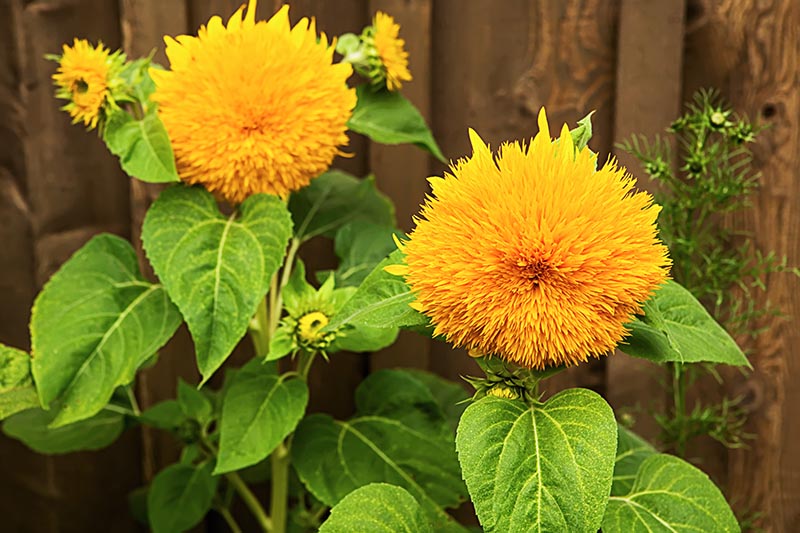
You can’t embrace them, no. But to me, a view of a few of their cheerful faces nodding and smiling in a border, or a sweet bouquet of these sunny, shaggy blooms in a vase, feels like a virtual hug.
Are you growing ‘Teddy Bear’ sunflowers? If you have any suggestions for succeeding with these sweeties, let us know in the comments below! And feel free to share a picture.
For more of the scoop on growing sunflowers, check out these guides next:
- How to Identify and Control Common Sunflower Pests
- How to Help Sunflowers That Won’t Bloom
- How to Protect Sunflowers From Birds and Squirrels
- 9 Popular Pollenless Sunflowers to Grow in Your Garden
© Ask the Experts, LLC. ALL RIGHTS RESERVED. See our TOS for more details. Product photo via True Leaf Market. Uncredited photos: Shutterstock.

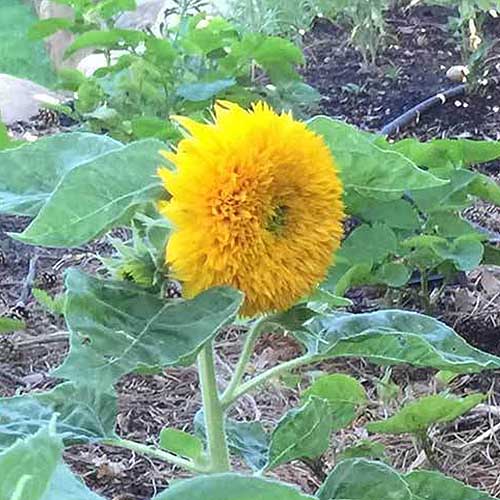
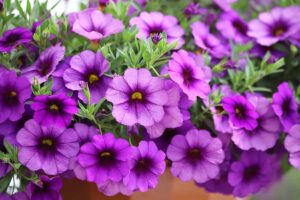
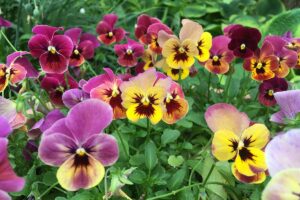
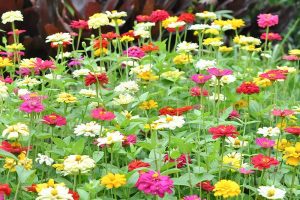
Gorgeous article with plenty of useful information. I grew ‘Teddy Bear’ sunflowers last year and I am doing it this year also. This year I started growing them indoors, because the temperature was not high enough. So as you said it is better to wait a few weeks and give them time. They are really pretty while in bloom, they make a nice impression!
Thanks so much, Luisa! Hope your sunflowers and all your plants are growing well.
My first year to try these and so far I am loving them! Planted them in a container this year but I’m thinking differently for next year.
Wow, Darla F Jenkins! Those look great, and I particularly like the pairing with the trailing vine.
If you do opt for planting them in a raised bed or garden next year, you’ll be able to get many more blooms without as much watering! Of course, you’ll also have to plan the companions and such. Good luck, and thanks for sharing this photo.
Out of the packet of different varieties of sunflower seeds I won on Instagram the end of 2021 & planted in the early summer 2022, only 1 seed grew. The 1 seed is a teddy bear sunflower. (I believe a mole ate my other seeds that were planted) I am obsessed with this stalk full of flowers! I’ve never heard of this variety & I will definitely be planting this variety every year. I’ve got 6 heads cut off & drying out on a rack face up in the garage.
Here’s my 1st & only teddy bear sunflower. I just posted a comment but didn’t have an attachment option so I’m doing a second comment. I’m obsessed with this gorgeous variety! ????
Hi Misti – here are your pictures – your flowers are gorgeous!
Hello Misti! Same here! So glad to hear from a fellow Teddy Bear fan!
Love these!
Me too, Misti Dane!
I love love love these fluffy wonders! This year I planted saved seeds from my last year Teddy Bears and one of them is absolutely MASSIVE way beyond imagination for a Teddy Bear. She towers over my porch roof line. Craziness huh?
That is a spectacular plant, Cathy! I suspect your last year’s flowers crossed with a ‘Russian Mammoth’ or something similar. I will look forward to seeing what the seeds from that beauty grow into if you save them for next year. Thanks for sharing.